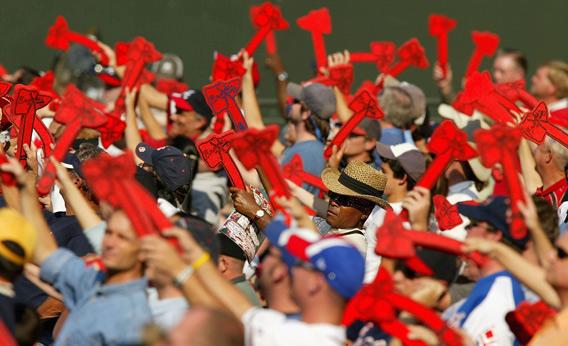Massachusetts Sen. Scott Brown tried to distance himself yesterday from staffers caught on video doing a tomahawk chop to mock opponent Elizabeth Warren’s claims of Native American ancestry. Where does the tomahawk chop come from?
Probably Florida. Florida State University adopted the Seminole as its symbol in 1947, and early depictions were of a Native American holding a tomahawk, the type of hatchet used by Colonial-era Native Americans and white colonists. It’s not clear exactly when Florida State fans began doing the tomahawk chop—a rhythmic extension and contraction of the forearm, with the palm open, to mimic the action of chopping—but a former FSU president once claimed that it was invented by the FSU marching band in the early 1980s. (Until 1972, the university used “Seminole Sammy,” a white student clad in fake Native American garb, as its mascot.)
Atlanta Braves fans adopted the in the early 1990s. According to most accounts, athletic renaissance man Deion Sanders, who had attended FSU, introduced the move to the Braves when he first played for the Georgia team in 1991.* Braves fans sometimes hold foam tomahawks when doing the chop, and they, like FSU fans, sing a wordless “war chant” in tandem with the chop during athletic events.
Like most professional athletic appropriations of Native American culture, the tomahawk chop and the war chant have little basis in Native American history. There is no indication that Native Americans ever made the gesture known today as the tomahawk chop. Tomahawks were historically not only used as weapons by Native Americans but also revered as sacred objects. Similarly, scalping—which FSU’s fight song encourages its athletes to do to their opponents—was practiced by both European settlers and Native Americans during the Colonial era, and it wasn’t widespread among Native Americans. The spread of the popular association of Native Americans with mock savagery probably dates to the early 20th century, around the time the Boy Scouts began using Native American-inspired terms and images in its curriculum.
Athletic teams’ use of Native American mascots has been subject to criticism repeatedly over the years for being insensitive and insulting to Native American people, and today the principal chief of the Cherokee Nation called Brown’s staffers’ use of the gesture “offensive and racist.”
Got a question about today’s news? Ask the Explainer.
Explainer thanks Andrew Jolivétte of San Francisco State University’s College of Ethnic Studies and Richard King of Washington State University’s Department of Comparative Ethnic Studies.
Correction, Sept. 26, 2012: This article originally stated that Deion Sanders introduced the tomahawk chop to the Atlanta Braves in 1992 and attributed its introduction to an urban legend. Sanders joined the Braves in 1991, and his introduction of the move is fairly well-documented. In addition, Sanders attended FSU but did not graduate. (Return to the corrected sentence.)
Video Explainer: Who Was Our Most Religious President?
